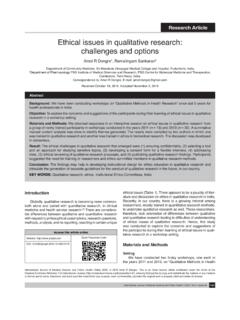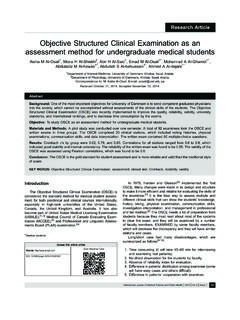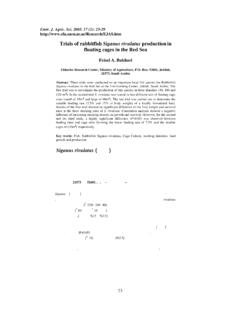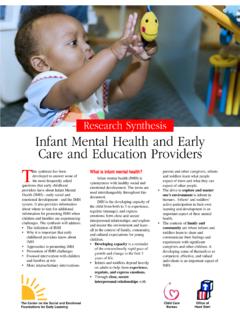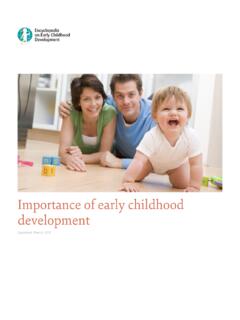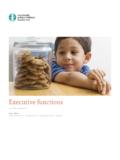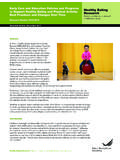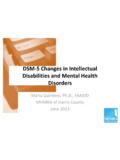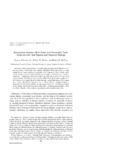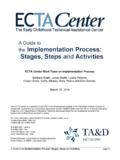Transcription of ZINC: THE TRACE ELEMENT OF MAJOR …
1 Jayant Deshpande et al. Zinc in human nutrition And health 1 International Journal of Medical Science and Public health | 2013 | Vol 2 | Issue 1 REVIEW ARTICLE ZINC: THE TRACE ELEMENT OF MAJOR IMPORTANCE IN human nutrition AND health Jayant D Deshpande1, Mohini M Joshi2, Purushottam A Giri1 1 Department of Preventive & Social Medicine, Rural Medical College, Loni, Maharashtra, India 2 Department of Anatomy, Rural Medical College, Loni, Maharashtra, India Correspondence to: Jayant D Deshpande DOI: Received Date: Accepted Date: ABSTRACT Zinc is an essential ELEMENT whose significance to health is increasingly appreciated. In 1961 essentiality of zinc for humans was recognized. A systematic literature search was done to identify relevant studies investigating the role of zinc in human health .
2 This review concerns the importance of zinc in health and the consequences of its deficiency. Zinc deficiency leads to complications of pregnancy and childbirth, low birth weight and poor growth in childhood, reduced immunocompetence, and increased infectious disease morbidity. Pregnant women with zinc deficiency are at risk of premature labour and miscarriages, inefficient labour and delivery, stillbirths, lower mental ability of the child, retarded foetal growth and low immunity of both mother and baby. Zinc can reduce the duration, severity and incidence of diarrhoea in children. Zinc deficiency was indicated as a risk factor for immune deficiency and susceptibility to infection in the elderly. Zinc is used in preventive trials and treatment of diarrhoea, pneumonia, common cold, respiratory infections and malaria.
3 Sufficient zinc is essential in maintaining immune system function. Supplementation of zinc and with other micronutrients may be beneficial during periods of greatest vulnerability such as early childhood, pregnancy and elderly. Ensuring adequate levels of zinc intake should be a key component in efforts to reduce illness. KEY-WORDS: Zinc; Deficiency; human health INTRODUCTION The importance of micronutrients in health and nutrition is undisputable, and among them, zinc is an essential ELEMENT whose significance to health is increasingly appreciated and whose deficiency may play an important role in the appearance of diseases. Nearly two billion people in the developing world are deficient in zinc.[1] In children it causes an increase in infection and diarrhea, contributing to the death of about 800,000 children worldwide per year.
4 [2] Zinc is one of the essential TRACE elements. Importance of zinc and its requirement for the growth of Aspergillus niger was first recognized by Raulin in 1869.[3] In 1934 the essentiality of zinc as TRACE ELEMENT for rats was observed.[4] In 1961 essentiality of zinc for humans was recognized.[5] Nutritionists have long been concerned that zinc deficiency affects large numbers of women and children worldwide. Several studies have now confirmed that zinc deficiency in the developing countries is fairly prevalent, and that growth retardation commonly observed in these countries may indeed be due to zinc deficiency.[6] Zinc deficiency was indicated as a risk factor for immune deficiency and susceptibility to infection in the elderly. Inadequate stores of zinc might be a risk factor of pneumonia in the elderly.
5 [7] Due to the wide prevalence of zinc deficiency and the multitude of zinc s essential biological functions, nutritional correction of zinc deficiency may have a significant impact on different aspects of human health . With this background in mind, present paper is an attempt to review role of zinc in health and disease. MAJOR CAUSES OF ZINC DEFICIENCY Zinc is present in all organs, tissues, and fluids of the body. The total body zinc of an adult human is approximately grams, or about of total weight. The physiological requirement for zinc in adult males is mg zinc/d; and mg/d for females.[8] The distinction between intake and absorption is important, because although some Jayant Deshpande et al. Zinc in human nutrition And health 2 International Journal of Medical Science and Public health | 2013 | Vol 2 | Issue 1 intakes of zinc may be acceptable, the levels of inhibitors ( fiber and phytates) in the diet may mean that inadequate amounts of zinc are absorbed.
6 Low levels of zinc or lack of zinc in the body result in zinc deficiency. Zinc deficiency can develop if the amount of zinc in the diet is insufficient relative to the requirement, or if the patients have such conditions as malabsorption, liver cirrhosis, diabetes mellitus, renal disease, haemolytic anaemia, burns, diarrhoea or intestinal fistula. Furthermore, zinc deficiency can be induced by continued use of low mineral purified foods (minerals are lost during purification), foods containing additives with chelating activity. Gastrointestinal surgery, Crohn's disease, ulcerative colitis, short bowel syndrome, and other digestive diseases can all decrease zinc absorption and increase zinc loss from the body. Acrodermatitis enteropathica, an inherited abnormality of zinc absorption, is rare.
7 Iron can interfere with zinc absorption, to reduce this effect, iron supplements should be taken between meals to allow time for zinc to be absorbed properly. In recent years, it has been suggested that zinc deficiency may be associated with carcinogenesis, senility, and the onset or progression of some lifestyle-related diseases.[9] A developing foetus requires a high amount of zinc; likewise, there is a high amount of zinc lost through breast milk after birth. The body requires more zinc during periods of rapid growth like pregnancy, infancy, childhood and adolescence. Children require more zinc to boost their delicate immune systems. Zinc deficiency is more likely to develop during childhood, when the daily requirement of zinc is higher, in adult women (especially young women on weight-reducing diets), and in elderly people whose dietary consumption of nutrients is poor.
8 Long-term high-calorie parenteral therapy is also important cause for zinc deficiency. For unknown reasons 44% of children and 60-70% of adults with sickle cell disease have low levels of zinc. Alcoholics - 30-50% of alcoholics have low levels of zinc because alcohol decreases zinc absorption and increases urinary secretion of zinc. In the USA, suboptimal zinc status has been noted in children of lower socioeconomic groups, low birth weight infants, pregnant teenagers and some of the elderly.[10] Research also suggests that the proportion of growth faltering attributable to zinc deficiency is likely greater in regions characterized by poor water and sanitation and hygiene practices that increase risk for diarrheal and respiratory infections, both of which increase the likelihood of zinc deficiency by increasing body losses or requirements.
9 [11] SOURCES OF ZINC Zinc is found in meat, liver, kidney, fish, chicken and cereals, eaten alongside vegetables to enhance zinc absorption. Fats and various non-nutritive foods, Fish, fruits, cakes, Poultry, pork, dairy products and whole grains, cereals, lamb, beef, leafy grains, root vegetables, shell fish , Oysters, lobster and organ meats. MAJOR plant sources of zinc include cooked dried beans, sea vegetables, fortified cereals, soyfoods, nuts, peas, and seeds. It is well known that zinc is present in many foods, but in most developing countries children have a low intake of foods rich in readily absorbable zinc, such as liver, red meat, poultry, fish, oysters, and crabs. Good sources of its mushrooms, day lily flowers, edible fungus, cabbage, black sesame, black rice, dates, hazelnuts, ebony and other vegetables, food crops and fruit.
10 Traditional staple foods, such as cereals, legumes, and tubers, contain zinc, but the presence of phytate, fiber, and lignin reduces its bioavailability. These substances form insoluble complexes with zinc, preventing its absorption. Cow s milk, because of its high concentrations of calcium and casein, and soymilk, because of its phytate content, may further reduce the absorption of zinc from the diet. In contrast, zinc in breast milk is well absorbed. Vegetables and fruits contribute very little to dietary zinc intake, but fruits eaten with cereals may increase the bioavailability of zinc.[12] The concentration of zinc in plants varies based on levels of the ELEMENT in soil. When there is adequate zinc in the soil, the food plants that contain the most zinc are wheat (germ and bran) and various seeds (sesame, poppy, alfalfa, celery and mustard).
